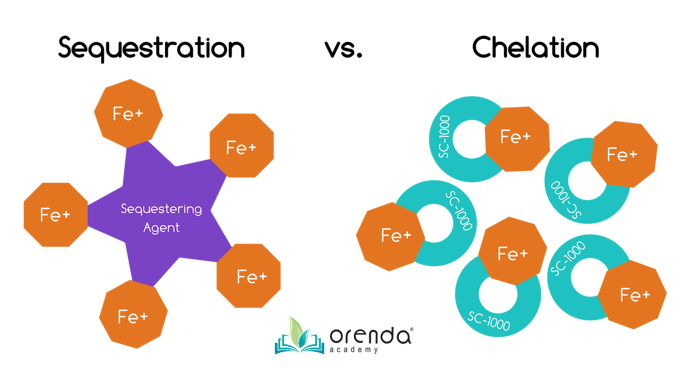What's the difference between SC-1000 and other metal and scale products?
SC-1000 is a chelating agent, whereas other scale inhibitors and metal/stain products are sequestering agents.
To understand the difference between SC-1000 and competitor products, we first must understand they are doing very similar things, but accomplishing them in a different way. In short, SC-1000 binds to metals and minerals individually, whereas other products cluster metals and minerals together into larger molecules.

Sequestering agents are like metal magnets. They attract metals and minerals to them, and when a metal is attached to a sequestering agent, it cannot be oxidized or carbonated. This prevents metal staining and inhibits scale formation. By the way, sequestering agents are very good at this.
Chelating agents like SC-1000 spread out and find metals, and individually bind to ions, keeping them separated. See the diagram above.
What are the advantages of sequestering agents over chelating agents?
Sequestering agents are generally less expensive, they are available in a number of different brands, and they work quickly if the water temperature is warm enough. In fact, they are so effective that drinking water treatment facilities often add them to protect the infrastructure from corrosion and/or scale formation, as well as protecting us (the end-users) from consuming harmful metals that can be more easily filtered out.
Chelating agents like SC-1000 are somewhat slower to activate, and if you are trying to filter out and remove metals, they are not as effective as sequestering agents. The molecule size is smaller. So unless you're using a metal-specific filter, SC-1000 is not a good product to use for metal removal. Also, purging with SC-1000 will wipe out your free chlorine for a few days until it has bound to metals/minerals, because chlorine attacks it–and loses. Generally speaking, sequestering agents do not wipe out chlorine levels, though some product labels advise lower levels of chlorine when adding the sequestering agent.
What are the advantages of SC-1000 over sequestering agents?
The short answer is longevity. SC-1000 is invulnerable to chlorine oxidization, unaffected by sunlight, and contains no phosphates.
Sequestering agents will eventually be oxidized out by chlorine, sunlight degrades them, and they are phosphate-based. That means phosphate removers like PR-10,000 and CV-700 will attack and remove sequestrants from water.
None of these products are effective below about 60-65ºF, but SC-1000 will not release its bond on metals/minerals when the temperature plunges, assuming it has already bound to them. In other words, for the long game, SC-1000 is a clear favorite.
The other advantage is SC-1000 is compatible with the Orenda Startup™ procedure, and sequestering agents are not. People have tried using sequestering agents with our Startup process, and it doesn't end well. Those products cannot do what SC-1000 does.
Which is better for scale prevention, and removal?
SC-1000, without a doubt.
Which is better for stain prevention, and removal?
This one is trickier. For stain prevention, SC-1000 is as good as anything else, and has more longevity to bind metals up for longer. But then again, if you're trying to remove those metals, it's not as good as a sequestering agent and filter.
As for stain removal, this clearly goes to sequestering agents. SC-1000 is not made to remove already-oxidized metals from surfaces. You'd need a citric acid/ascorbic acid to lift the stain, then SC-1000 can grab it. But again, SC-1000 alone is not meant to remove stains.
.png?width=688&name=SC-1000%20(1).png)